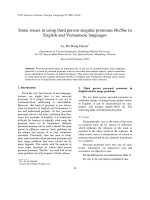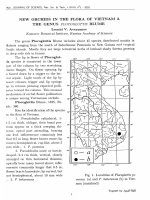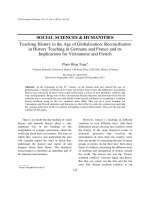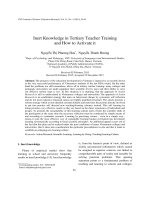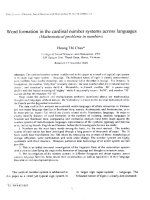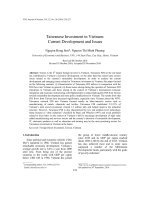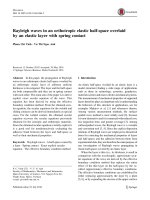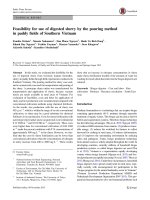DSpace at VNU: Magnetocaloric effect in Fe-Ni-Zr alloys prepared by using the rapidly-quenched method
Bạn đang xem bản rút gọn của tài liệu. Xem và tải ngay bản đầy đủ của tài liệu tại đây (327.25 KB, 5 trang )
Journal of the Korean Physical Society, Vol. 62, No. 12, June 2013, pp. 1715∼1719
Magnetocaloric Effect in Fe-Ni-Zr Alloys Prepared
by Using the Rapidly-quenched Method
Nguyen Huy Dan,∗ Nguyen Huu Duc, Tran Dang Thanh, Nguyen Hai Yen and Pham Thi Thanh
Institute of Materials Science, Vietnam Academy of Science and Technology, 18 Hoang Quoc Viet, Hanoi, Vietnam
Ngac An Bang and Do Thi Kim Anh
Hanoi University of Science, 334 Nguyen Trai, Hanoi, Vietnam
The-Long Phan and Seong-Cho Yu†
Chungbuk National University, Cheongju 361 - 763, South Korea
(Received 31 May 2012, in final form 21 July 2012)
Fe90−x Nix Zr10 (x = 0, 5, 10, 15, 20 and 25) ribbons with various thicknesses were prepared by
using a melt-spinning technique. The Curie temperature, TC , of the alloys dramatically decreased
from ∼960 K to room temperature at high quenching rates. When the alloys had an amorphous
structure, their TC strongly depended on the Ni concentration. The maximum entropy change,
|∆Sm |max , with ∆H = 12 kOe, of the alloys was around 1 J·kg−1 K−1 at room temperature. On
the other hand, the full width at half maximum the entropy-change peak was quite large, ∼ 85 K,
which was suitable for applications in magnetic refrigerators at room temperature.
PACS numbers: 75.30.Sg, 07.20.Mc, 75.50.Kj
Keywords: Magnetocaloric effect, Refrigeration, Amorphous magnetic materials
DOI: 10.3938/jkps.62.1715
I. INTRODUCTION
The giant magnetocaloric effect (GMCE) in materials
is of interest in research virtue of its potential applications in the field of magnetic refrigeration. Magnetic refrigeration is based on the principle of magnetic entropy
change in materials under a varying magnetic field. The
application of magnetocaloric materials in refrigerators
has the advantages of avoiding environmental pollution
(unlike the refrigerators using compressed gases), improving the cooling efficiency (saving energy), reducing
noise, and fitting some special cases. The main problems
to be addressed to improve the practical applications of
magnetocaloric materials are: i) creating the GMCE in a
low field, because creating a large magnetic field in civil
devices is very difficult, ii) taking the magnetic phase
transition temperature (working temperature) of materials with the GMCE to room temperature, and iii) extending the working temperature range (range with the
GMCE) for materials to be cooled to a large temperature
range. In addition, some other properties of materials,
such as the heat capacity, electrical conductivity, thermal conductivity, durability, price, etc., also need to be
∗ E-mail:
† E-mail:
addressed for the application of GMCE materials.
Along with the goal of saving energy and protecting
the environmental, searches for magnetocaloric materials with capabilities for applications in magnetic refrigeration at room temperature are increasingly of interest in research. Notably, the results obtained for
Gd-containing magnetocaloric alloys (GdSiGe, GdCo. . .)
[1, 2] have shown capabilities for extensive applications
of magnetic refrigeration technology. A number of devices using magnetic refrigerants have been experimentally produced with Gd-containing magnetocaloric alloys. However, Gd-containing alloys have very high
costs due to the scarcity of raw materials and the strict
manufacturing technology. In addition, Gd-containing
alloys do not satisfy a number of other requirements
such as strength and thermal conductivity. Besides Gdcontaining alloys, some of other magnetocaloric materials
are of interest in studies on the mechanisms and possible
applications. These materials include As-containing alloys (MnAsSb, MnFePAs. . .) [3, 4], La-containing alloys
(LaFeSi), Heusler alloys (CoMnSi, NiMnSn, NiMnGa. . .)
[5,6] and ferromagnetic perovskite maganites [7,8].
Recently, many researchers have focused on magnetocaloric materials with amorphous or nanocrystalline
structures [9–12].
The main advantages of amorphous or nanocrystalline materials are their capabilities
-1715-
-1716-
Journal of the Korean Physical Society, Vol. 62, No. 12, June 2013
for the GMCE, low coercivity, high resistivity, roomtemperature magnetic phase transition and low cost,
which are necessary requirements for practical applications. Among this kind of GMCE materials, the Fe-Zrbased alloys have been attracting the attention of many
scientists [13–19]. In this work, we investigate the magnetocaloric effect in Fe-Ni-Zr alloys prepared by using
the rapidly-quenched method
II. EXPERIMENTS AND DISCUSSION
The alloys with nominal compositions of
Fe90−x Nix Zr10 (x = 0, 5, 10, 15, 20 and 25) were
prepared from pure metals (99.9%) of Fe, Ni and Zr.
An arc-melting method was first used to ensure the
homogeneity of the alloys. A melt-spinning method
with various quenching rates was then used to fabricate
the ribbon samples. The variation of the quenching rate
depended on such factors as the tangential velocity of
the copper wheel, the hole in the quartz crucible, the
injection pressure, etc. The thickness (d) of the ribbon
is commonly used to distinguish the quenching rate of
the ribbon. In this work, the ribbons with thicknesses
of 15 and 30 µm were investigated. The structure of the
samples was examined by using powder X-ray diffraction
(XRD). The magnetic properties of the samples were
characterized by using magnetization measurements.
Figure 1 shows XRD patterns of Fe90−x Nix Zr10 ribbons with various thicknesses. Diffraction peaks corresponding to the crystalline phases of α-Fe, FeNi and
NiZr2 are observed in these patterns. However, the crystalline fraction in all the samples is small, i.e., the amorphous phase is dominant. We can see that the diffraction
peaks of the thinner (d = 15 m) ribbons, especially the
ones with x = 0 - 15, are very weak, which means these
ribbons are almost amorphous. The structural phase
fraction strongly influences the magnetic properties of
the alloys as presented below.
Thermomagnetization measurements was performed
for Fe90−x Nix Zr10 ribbons with different thickness. Figure 2 presents reduced thermomagnetization curves for
some typical ribbons. The thermomagnetization curves
of the ribbons with d = 30 µm manifest their multi-phase
behaviors. These ribbons have a magnetic phase transition in the temperature range of 250 - 500 K corresponding to the amorphous phase. After the first transition,
the magnetization of these ribbons does not decrease to
zero, but maintains values characterizing the crystalline
phase. The magnetic transition in the temperature range
of 250 - 500 K is thought to be of an amorphous nature
because the ribbons prepared at a high quenching rate
(their structure is fully amorphous) only have this transition. As for the ribbons prepared at a low queching rate,
their structure is partly crystalline (the lower the quenching rate, the higher the crystalline fraction). The magnetization of the ribbon prepared at temperature above 500
Fig. 1. XRD patterns of Fe90−x Nix Zr10 ribbons with d =
(a) 30 µm and (b) 15 µm.
Fig. 2. (Color online) Reduced thermomagnetization
curves in a magnetic field for 100 Oe of Fe90−x Nix Zr10 ribbons
with d = 30 µm. The inset shows the thermomagnetization
curves in a magnetic field of 10 Oe of Fe90−x Nix Zr10 ribbons
with d = 15 µm.
K is that of a crystalline phase, which has a Curie temperature higher than that of an amorphous phase, and
its magnitude is directly proportional to the crystalline
Magnetocaloric Effect in Fe-Ni-Zr Alloys Prepared · · · – Nguyen Huy Dan et al.
-1717-
Table 1. Influence of Ni concentration on the coercivity (Hc), Curie temperature (TC ), maximum entropy change (|∆Sm |max ),
full width at half maximum (FWHM) of the entropy-change peak and refrigerant capacity (RC) of Fe90−x Nix Zr10 ribbons with
d = 15 µm (∆H = 12 kOe).
Ni (%)
0
5
10
15
Hc (Oe)
30
12
11
12
TC (K)
245
306
356
403
|∆Sm |max (J·kg−1 K−1 )
0.93
1.09
1.02
0.95
Fig. 3. (Color online) Hysteresis loops at 300 K of
Fe90−x Nix Zr10 ribbons with d = 15 µm. The inset shows
the magnetization at a field of 12 kOe vs Ni concentration in
the samples.
fraction; i.e., it depends on the quenching rate. The
magnetization is then increased considerably by heating
the ribbons. This is due to the overall crystallization
in the ribbons. The magnetization of all the ribbons
reaches zero after the last magnetic transition at a temperature of about 960 K. As for the ribbons with d =
15 µm, their magnetization is almost zero after the first
magnetic transition. This is in agreement with the above
structure analysis. These ribbons are almost amorphous
resulting in a single magnetic phase transition. Thus,
the quenching rate plays an important role in reducing
the Curie temperature from a high value to a value in
the room temperature region. The quenching rate must
be high enough to make the alloys fully amorphous in
the solid state. It should be noted that the Curie temperature of the amorphous phase is considerably raised
with increasing Ni concentration in the alloy. To the contrary, the Curie temperature of Fe90−x Mnx Zr10 ribbons
is decreased with increasing Mn concentration [5]. These
different trends in the variation of the Curie temperature
of the alloy can be understood in terms of the exchange
interaction. The exchange interaction of atoms in the alloy is enhanced by Ni, but reduced by Mn. The effect of
the Ni concentration on the Curie temperature has a sig-
FWHM (K)
92
83
79
74
RC (J·kg−1 )
86
90
81
70
Fig. 4. (Color online) Thermomagnetization curves in various magnetic field of Fe90−x Nix Zr10 ribbons with d = 15 µm.
The inset shows the magnetization vs. magnetic field at 300
K obtained from virgin magnetization (dir.) and thermomagnetization (ind.) curves.
nificant meaning in controlling the working temperature
of the magnetic refrigerants. Figure 3 shows the dependence of the magnetization on the external field and the
Ni concentration of the ribbons with d = 15 µm. We
can see that, the ribbons have a soft magnetic feature
and that their magnetization increases with increasing
Ni concentration. The results indicate that the addition
of Ni can decrease the coercivity (see Table 1) and increase the saturation magnetization of the alloy. These
two effects of Ni improve its capacity for applications in
magnetic refrigeration.
According to the obtained results, we selected four
samples of Fe90−x Nix Zr10 (x = 0, 5, 10 and 15) ribbons
with d = 15 µm to investigate their GMCE. These samples showed a single magnetic phase transition at temperatures near room temperature, which is necessary for
practical applications of magnetic refrigerants. In this
study, we calculate the magnetic entropy change, ∆Sm ,
based on thermomagnetization data (Fig. 4). From
the thermomagnetization curves for the samples in various magnetic fields, we can deduce the magnetization
vs magnetic field, M (H), at various temperatures (Fig.
-1718-
Journal of the Korean Physical Society, Vol. 62, No. 12, June 2013
Fig. 5. (Color online) Magnetization vs magnetic field at
various temperatures an deduced from the thermomagnetization curves of Fe85 Ni5 Zr10 ribbons with d = 15 µm.
5). This derivation was checked by comparing data (direct data) for a virgin magnetization curve with those
(indirect data) deduced from the thermomagnetization
curves (inset of Fig. 4). We found that the data obtained from the two different ways agreed. The ∆Sm
was then determined from the M (H) data by using the
following relation:
H2
∆Sm =
H1
∂M
∂T
H
dH
(1)
By using the proposed method to calculate the entropy
change of magnetocaloric materials, we could save experimental time and expense. This method is also useful for
avoiding the effect of thermal fluctuations in the measurement systems.
Figure 6 presents ∆Sm (T ) curves (∆H = 12 kOe) for
the Fe90−x Nix Zr10 (x = 0, 5, 10 and 15) ribbons with
d = 15 µm. The maximum entropy change (|∆Sm |max )
of the alloy is nearly unchanged (∼1 J·kg−1 K−1 with
∆H = 12 kOe) while the full width at half maximum
(FWHM) of the entropy change peak gradually decreases
(from 92 K to 74 K) with increasing Ni concentration
(see Table 1). The refrigerant capacity (RC) of the samples, which is defined as the product of the maximum
entropy change (∆Smax ) and the full width at half maximum (FWHM) of the entropy change peak, was also
calculated (see the inset of Fig. 6). The RC of the alloy first increases and then decreases with increasing Ni
concentration from 0 to 15 at%. Nevertheless, a maximum RC of about 90 J·kg−1 is achieved at a Ni concentration of 5 at% for temperature around room temperature. This RC of the Fe90−x Nix Zr10 alloys is higher
than those of some amorphous and nanocrystalline alloys
such as Finemet (Fe68.5 Mo5 Si13.5 B9 Cu1 Nb3 ), Nanoperm (Fe83−x Cox Zr6 B10 Cu1 , Fe91−x Mo8 Cu1 Bx ), HiT-
Fig. 6. (Color online) ∆Sm (T ) curves (∆H = 12 kOe) of
Fe90−x Nix Zr10 ribbons with d = 15 µm. The inset indicates
the refrigerant capacity (RC) vs. Ni concentration of the
alloy.
perm (Fe60−x Mnx Co18 Nb6 B16 ), and bulk amorphous alloys (Fex Coy Bz CuSi3 Al5 Ga2 P10 ) [6].
Table 1 present a summary of the influence of the Ni
concentration on the coercivity (Hc ), Curie temperature
(TC ), maximum entropy change (|∆Sm |max ), full width
at half maximum (FWHM) of entropy change peak, refrigerant capacity (RC) of the Fe90−x Nix Zr10 (x = 0, 5,
10 and 15) ribbons with d = 15 µm. In comparison with
other materials, we can see that the Fe-Ni-Zr alloy is
a good candidate for practical applications in magnetic
refrigeration technology.
III. CONCLUSION
The Curie temperature of the Fe-Ni-Zr alloy can be
regulated in the region of room temperature by choosing an appropriate quenching rate and Ni concentration.
The quite high maximum entropy change, |∆Sm |max >
1 J·kg−1 K−1 for ∆H = 12 kOe, and the wide working range around room temperature, ∆T ∼ 85 K, reveal
potential applications of the rapidly-quenched Fe-Ni-Zrbased alloys in magnetic refrigeration technology.
ACKNOWLEDGMENTS
This work was supported by the National Foundation for Science and Technology Development (NAFOSTED) of Vietnam under grant number of 103.02-2011.23
and the Converging Research Center Program funded
by the Ministry of Education, Science and Technology
(2012K001431), South Korea. A part of the work was
Magnetocaloric Effect in Fe-Ni-Zr Alloys Prepared · · · – Nguyen Huy Dan et al.
done in the Key Laboratory for Electronic Materials and
Devices, and Laboratory of Magnetism and Superconductivity, Institute of Materials Science, in Vietnam.
REFERENCES
[1] V. Provenzano, A. J. Shapiro and R. D. Shull, Nature
429, 853 (2004).
[2] V. K. Pecharsky and K. A. Gschneidner, Phys. Rev. Lett.
78, 4494 (1997).
[3] O. Tegus, B. Fuquan, W. Dagula, L. Zhang, E. Br¨
uck,
P. Z. Si, F. R. de Boer and K. H. J. Buschow, J. Alloy.
Comp. 396, 6 (2005).
[4] L. G. Medeiros, N. A. Oliveira and A. Troper, J. Alloy.
Comp. 501, 177 (2010).
[5] T. Krenke, E. Duman, M. Acet, E. F. Wassermann, X.
Moya, L. Manosa and A. Planes, Nature Materials 4, 450
(2005).
[6] X. Zhou, W. Li, H. P. Kunkel and G. Williams, J. Phys.:
Condens. Matter 16, L39 (2004).
[7] M. H. Phan, H. X. Peng and S. C. Yu, J. Magn. Magn.
Mater. 316, 562 (2007).
[8] D. N. H. Nam, N. V. Dai, L. V. Hong, N. X. Phuc, S.
C. Yu, M. Tachibana and E. Takayama-Muromachi, J.
Appl. Phys. 103, 043905 (2008).
-1719-
[9] V. Franco, C. F. Conde, A. Conde and L. F. Kiss, Appl.
Phys. Lett. 90, 052509 (2007).
[10] J. Kovac, P. Svec and I. Skorvanek, Rev. Adv. Mater.
Sci. 18, 533 (2008).
[11] D. Wua, S. Xue, J. Frenzel, G. Eggelerc, Q. Zhai and H.
Zheng, Mater. Sci. Eng. A 534, 568 (2012).
[12] R. Zeng, S. Q. Wang, G. D. Du, J. L. Wang, J. C. Debnath, P. Shamba, Z. Y. Fang and S. X. Dou, J. Appl.
Phys. 111, 07E144 (2012).
[13] S. G. Min, K. S. Kim and S. C. Yu, H. S. Suh and S. W.
Lee, J. Appl. Phys. 97, 10M310 (2005).
[14] V. Franco, J. S. Bl´
azquez, M. Mill´
an, J. M. Borrego, C.
F. Conde and A. Conde, J. Appl. Phys. 101, 09C503
(2007).
[15] D. Mishra, M. Gurram, A. Reddy, A. Perumal, P. Saravanan and A. Srinivasan, Mater. Sci. Eng. B 175, 253
(2010).
[16] R. Caballero-Flores, V. Franco, A. Conde, K. E. Knipling
and M. A. Willard, Appl. Phys. Lett. 96, 182506 (2010).
[17] Z. M. Stadnik, P. Griesbach, G. Dehe and P. Giitlich, T.
Miyazaki, Phys. Rev. B 35, 430 (1987).
[18] K. S. Kim, B. S. Kang, S. C. Yu and Y. S. Kim, J. Korean
Phys. Soc. 57, 1605 (2010).
[19] K. S. Kim, Y. S. Kim, J. Zidanic, S. G. Min and S. C.
Yu, Phys. Stat. Solid. 204, 4096 (2007).
